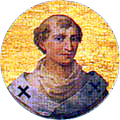Pope Benedict IX
Pope Benedict IX (Latin: Benedictus Nonus; c. 1012–1056), born Teofilatto or Theophylactus of Tusculum, was an Italian priest of the Roman Catholic Church and the 145th Pope from 1032 to 1045.[1] He is listed as the 147th Pope in 1045.[1] Also, he was the 150th Pope in 1047-1048.[1]
Benedict IX | |
|---|---|
 | |
| Papacy began | October 1032 (first term) |
| Papacy ended | July 1048 (third term) |
| Predecessor | Pope John XIX Pope Sylvester III Pope Clement II |
| Successor | Pope Sylvester III Pope Gregory VI Pope Damasus II |
| Personal details | |
| Birth name | Teofilatto or Theophylactus |
| Born | c. 1012 |
| Died | January 1056 Papal States |
| Other popes named Benedict | |
Early life change
Teofilatto was born in Rome c. 1012. He was the son of Alberic III[2] of the noble Tusculum family.[3]
He was the nephew of both Pope Benedict VIII and Pope John XIX.[4]
Cardinal change
John XIX raised Teofilatto to the rank of a cardinal; but the date is unknown.
Pope change
In 1032, Alberic III used his money and influence to make his son the pope. This was called simony.[5] Pope Benedict chose his name in honor of his uncle, Benedict VIII.[6]
Benedict is usually recognized as having had three terms or reigns as pope
First term change
Benedict's first period as pope lasted from 1032 to 1044 when a revolt in Rome forced Benedict out of the city;[7] and an antipope was elected with the name of Sylvester III.[8]
Second term change
Benedict's second period as pope lasted from his return six months later to 1045 when he sold his title to John Gratianus,[7] who was then made pope with the name of Gregory VI.[9] Benedict abdicated or resigned.[10]
In 1046, there were three men with the title of pope. The problem was solved by electing a new pope with the name of Pope Clement II,[11] who died a short time later.
Third term change
When the death of Clement II in 1047, Benedict IX tried to claim the papacy again, but was driven out of Rome by German troops. The timely election of Pope Damasus II became unimportant when he died 23 days later.[7]
After 1048, Benedict's importance faded;[12] and Pope Leo IX was elected in 1049.[7]
After his death change
Benedict IX was buried in the Abbey of Grottaferrata c. 1056.
Related pages change
References change
- ↑ 1.0 1.1 1.2 "List of Popes," Catholic Encyclopedia (2009); retrieved 2011-11-3.
- ↑ Williams, George L. (2004). Papal Genealogy: The Families and Descendants of the Popes. McFarland. p. 12. ISBN 978-0-7864-2071-1.
- ↑ The Tusculum family are also known as the Tuscolani
- ↑ "Pope Benedict IX", Catholic Encyclopedia; retrieved 2011-11-3.
- ↑ Encyclopaedia Britannica: A Dictionary of Arts, Sciences, and General Literature. R.S. Peale. 1891. p. 558.
- ↑ Room, Adrian (2012). Dictionary of Pseudonyms: 13,000 Assumed Names and Their Origins, 5th ed. McFarland. p. 56. ISBN 978-0-7864-5763-2.
- ↑ 7.0 7.1 7.2 7.3 The Penny Cyclopædia of the Society for the Diffusion of Useful Knowledge. C. Knight. 1835. p. 214.
- ↑ "Antipope" (Sylvester III), Catholic Encyclopedia (2009); retrieved 2011-11-02.
- ↑ "Pope Gregory VI", Catholic Encyclopedia (2009); retrieved 2011-11-02.
- ↑ "Abdication," Catholic Encyclopedia; retrieved 2013-2-11.
- ↑ "Pope Clement II", Catholic Encyclopedia (2009); retrieved 2011-11-02.
- ↑ "Pope Damasus II", Catholic Encyclopedia (2009); retrieved 2011-11-02.
- ↑ Stemmi Papali, Benedetto IX (in Italian); retrieved 2011-11-3
Other websites change
Media related to Benedictus IX at Wikimedia Commons
- . Catholic Encyclopedia. New York: Robert Appleton Company. 1913.
- Catholic Hierarchy, Popes in sequence
- Cardinals of the Holy Roman Church, Cardinal Teofillato
| Preceded by John XIX |
Pope 1032–1044 |
Succeeded by Sylvester III |
| Preceded by Sylvester III |
Pope 1045 |
Succeeded by Gregory VI |
| Preceded by Clement II |
Pope 1047–1048 |
Succeeded by Damasus II |